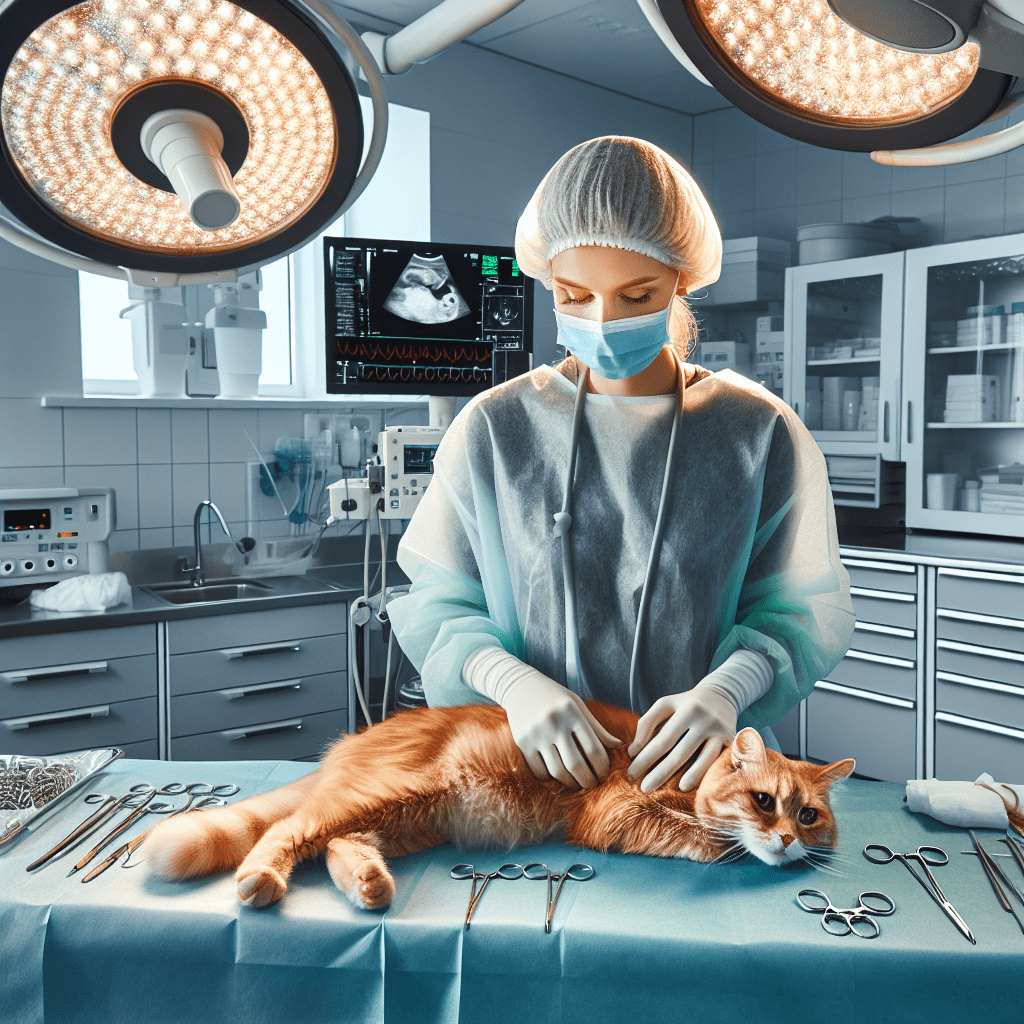Introduction to the Importance of Spaying/Neutering Cats
Spaying and neutering cats is a crucial responsibility for pet owners. Ensuring the health and welfare of our feline friends requires more than just love and affection. It involves making informed decisions about their care, and one of the most significant choices is whether to spay or neuter your cat. This guide will explore why this procedure is essential when it should be done, and how it benefits both your pet and the community.
You’ll find answers to common questions and concerns, detailed explanations of the surgery process, and valuable insights into your cat’s overall well-being. By the end, you will understand why spaying and neutering are vital steps towards responsible pet ownership.
Table of Contents
At What Age Can Cats Be Safely Spayed/Neutered?
Figuring out when to spay or neuter your cat is critical to its health and safety. Most vets say around five to six months is good, aligning with puberty at around four months. You can do it even earlier, at eight weeks, but you need an experienced vet. Early procedures have perks like quicker recovery and fewer risks. The right time depends on your cat’s health, breed, and lifestyle. Chatting with your vet will help you decide what’s best for your feline friend.
Concerns About Early Spay/Neuter
While it’s great to consider early spaying and neutering for your pets, some folks worry about doing it too soon. One big concern is how it might affect growth and development. Removing those hormones early could mess with how limbs grow, changing how the whole body shapes up. Plus, there’s talk about how it could mess with a cat’s hormone system long-term, messing with how fast they burn calories and upping the chance of getting chubby.
Then there’s the worry that early spaying/neutering could make cats more prone to specific health issues. Some studies hint at a link between early spaying/neutering and a higher risk of stuff like urinary tract problems, especially in male cats. Scientists are still investigating whether there’s a connection between early spay/neuter and other health problems, like bone issues or some cancers.
Even with all these worries, it’s key to consider the pros and cons case by case. Chatting with a vet who knows their stuff can help you figure out what’s best for your furry friend. When deciding on the timing, it’s important to consider your cat’s health history and how it could help cut down on pet overpopulation and related health troubles.

Benefits of Early Spaying/Neutering
Health Benefits
Spaying and neutering offer numerous health advantages for cats. Because of reproductive diseases, these procedures significantly reduce the risk of uterine infections, ovarian cancers, and testicular cancers. Furthermore, spaying eliminates the risk of pyometra, a life-threatening infection of the uterus.
Behavioral Benefits
Are they thinking about early spaying or neutering? Here’s a perk: neutered males are less likely to act aggressively, mark territory, or roam around. And have they spayed females? They won’t go into heat, saving the cat and the owner from a stressful experience.
Population Control
One of the most critical benefits of early spaying and neutering is population control. Feral and stray cat populations contribute to overcrowded shelters and increased euthanasia rates. By spaying or neutering your cat, you are actively participating in reducing the number of unwanted litters and alleviating the burden on animal shelters.

Reasons to Perform Early Spay/Neuter
Reducing the Risk of Reproductive Diseases
Ensuring your cat is spayed or neutered early is vital to avoid future reproductive problems. For optimal health, it is recommended to spay female cats before their first heat cycle. Significantly reduce the risk of mammary tumors. Similarly, early neutering for male cats can lower the chances of testicular cancer or prostate issues. Taking these steps early can boost your furry friend’s health and lifespan!
Enhancing Behavioral Stability
Getting your cat spayed or neutered early can improve their behavior. Cats that undergo this process when they’re young usually become more relaxed and less prone to being aggressive or territorial. It’s a win-win as it helps pets get along better at home. And hey, early spaying in females prevents them from going into heat, saving them that whole hassle and worry. Neutering male cats also helps reduce their urge to roam around, which means fewer accidents and health risks.
Contributing to Population Control
One of the paramount reasons to spay or neuter early is controlling the feline population. Overpopulation remains a critical issue, leading to strained animal shelters and increased euthanasia rates. By opting for early spaying or neutering, pet owners contribute to curbing the number of unwanted kittens, reducing the burden on shelters and the frequency of euthanasia. This proactive measure supports the broader community by mitigating the challenges associated with overcrowded shelters.
What to Expect During and After the Surgery
The Surgical Procedure
Spaying and neutering are routine surgical procedures performed under general anesthesia. For spaying (ovariohysterectomy), the veterinarian removes the ovaries and uterus of female cats. Neutering (orchiectomy) involves the removal of the testicles in male cats. Both surgeries are relatively quick, typically lasting 30 minutes to an hour.
Post-Surgery Care
After the surgery, your kitty will need some time to recover. Most cats can go home on the same day, but they have a comfy spot to relax. Watch your furball for any red flags like swelling, redness, or anything funky coming out of the surgery spot. Also, ensure they keep the cut – that can cause some issues with Timeline.
After being spayed or neutered, cats usually bounce back within 10 to 14 days. Make sure they take it easy during this period to avoid any strain don’t incision. Your vet will give you all the details you need for their care, like pain relief and follow-up visits to ensure they recover smoothly.
Addressing Common Concerns and Debunking Myths about Spaying/Neutering Cats
Myth 1 Spaying/Neutering Will Change My Cat’s Personality
A common misconception is that spaying or neutering will drastically alter your cat’s personality. While there may be some changes, such as reduced aggression or territorial behavior, these are usually positive. Cat’s fundamental personality traits, such as playfulness and affection, will remain uncaused.
Myth 2: It’s Better to Allow My Cat to Have One Litter First
Some believe that allowing a cat to have one litter before spaying affects its health or behavior. However, there is no scientific evidence to support this claim. In fact, eat ‘spaying provides the same health and behavioral benefits without the added stress and risk associated with pregnancy and childbirth.
Myth 3: Spaying/Neutering is Too Expensive
Are you thinking about the cost of spaying or neutering your pet? Don’t worry! Many organizations provide low-cost or free services to help pet owners like you. Just imagine the money you’ll save in the long run by preventing health problems and unwanted litter. It’s smart and budget-friendly. Don’t choose to invest in spaying or neutering.
Conclusion
Spaying and neutering are super important for taking care of your fur buddy. These procedures help your cat stay healthy and well-Its’ve and ensure we don’t have too many kittens running around and filling up chatting fixed, chatting with your vet if you’re considering getting your cat fixed is the way to go. Let’s work together to give our feline pals a brighter future! And don’t, if you want more tips on being a great pet parent, sign up for our news you’re or reach out to our awesome vets today.
Frequently Asked Questions (FAQ)
How old would my cat be before spaying or neutering?
It’s usually best to spay or neuter cats when they’re between 8 weeks and six months old. Doing it early, especially before a female cat’s first heat cycle, can really help cut down on the chance of reproductive diseases.
How long does the spaying/neutering procedure take?
The they’re or neutering procedure typically lasts between 30 minutes to an hour, depended cat’s the age, size, and health of the cat. Your veterinarian will inform you about the Timeline and any specific needs your pet may have.
Will my cat experience pain during and after the surgery?
When your cat gets spayed or neutered, they’re under general anesthesia to make sure they don’t feel a thing. Your vet will give you all the info you need on pain management for your fur ball’s recovery at home.
What are the risks associated with spaying/neutering?
Likethey’rergery, there are risks involved. Yet, trust a skilled vet; complications are extremely rare. Plus, the benefits of spaying/neuter furballs outweigh those minimal risks!
Can my cat eat or drink before the surgery?
Your veterinarian will provide specific pre-surgical instructions, which often include fasting. Cats should not eat or drink for at least 8 to 12 hours before surgery. Always follow your veterinarian’s guidance for the best outcome.
How should I care for my cat after the surgery?
Post-surgery care involves
- providing a quiet and comfortable space for your cat to rest,
- monitoring the incision site for signs of infection and
- preventing your cat from licking or biting at the surgical site.
Your veterinarian will give detailed aftercare instructions to ensure a smooth recovery.
Will spaying/neutering affect my cat’s weight?
When you spay or neuter your cat, it might tone down its energy levels, possibly leading to weight gain if not handled well. Just make sure to give it a balanced diet and keep it active to help it stay at a healthy weight.
Can I spay or neuter an older cat?
Yes, older cats can be spayed or neutered. However, the risks associated with surgery may be slightly higher in older pets. It’s important to consult with your veterinarian to assess your cat’s overall health before proceeding.
Sarah Smith is a passionate dog and cat enthusiast, blogger, and pet care expert. With years of experience researching and writing about various dog breeds cat breeds, she brings a wealth of knowledge and insight to her blog, PetPession.com. Sarah loves exploring the unique traits, histories, and care needs of different breeds, helping pet owners make informed decisions. Her mission is to create helpful, friendly, and well-researched content that both educates and celebrates the joy of pet ownership. When she’s not writing, Sarah enjoys outdoor adventures with her own furry friends.

